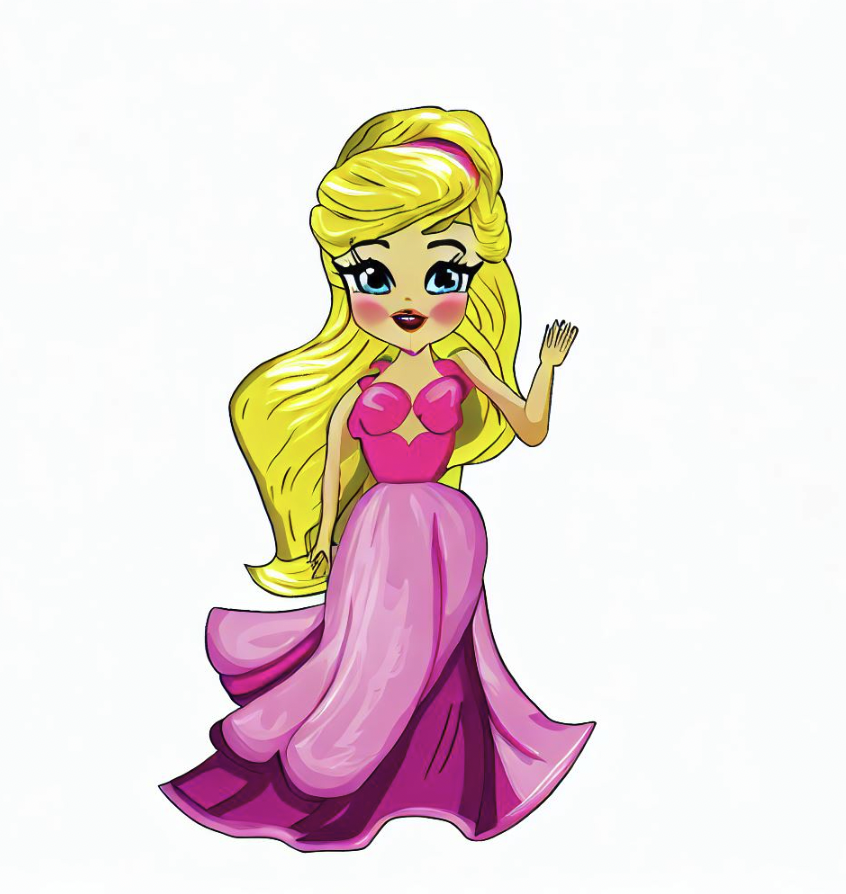Barbie, the iconic fashion doll that has graced toy shelves for generations, has a rich history that spans over several decades.
From her inception to her ever-evolving persona, Barbie has managed to remain a beloved figure in the hearts of many.
How Old Is Barbie?
Barbie, the iconic fashion doll, was first introduced by the American toy company Mattel, Inc. on March 9, 1959.
Below we look more into the age-old question: “How old is Barbie?” and explore the unique facets that have contributed to her timeless charm.
Table of Contents
The Birth of an Icon
The Inception of Barbie
Barbie made her grand debut on March 9, 1959, which marks her official birthday.
Ruth Handler, the co-founder of Mattel, was inspired to create Barbie after noticing her daughter’s fascination with adult paper dolls.
This observation led to the birth of Barbie, a fashion doll that would allow girls to envision their futures in various roles and professions.
The Evolution of Barbie
Over the years, Barbie has undergone numerous transformations, adapting to the changing times and preferences of her audience.
From her initial representation as a fashion model, Barbie has taken on a myriad of roles, including astronaut, president, and even a supermodel.
This ability to evolve and adapt has played a significant role in maintaining her popularity over the years.
From the archives: Barbie creator Ruth Handler on her life before and after the doll
Barbie’s Impact on Society
Breaking Gender Stereotypes
Barbie has been a trailblazer in breaking gender stereotypes, showcasing that girls can aspire to be anything they want to be.
Through her various careers and roles, Barbie has encouraged girls to dream big and break free from the traditional gender roles that society has imposed upon them.
A Tool for Education
Apart from being a beloved toy, Barbie has also served as a tool for education.
With the introduction of various themed dolls, including those focusing on science, technology, engineering, and mathematics (STEM), Barbie has encouraged young girls to explore fields traditionally dominated by men, fostering a generation of empowered and educated women.
The History of Barbie | A Guided Tour by Trixie Mattel
The Legacy of Barbie
A Cultural Phenomenon
Barbie’s influence extends beyond the toy aisle, permeating various aspects of popular culture.
From movies to fashion, Barbie has become a cultural phenomenon, inspiring artists and designers alike.
Her iconic pink color and distinctive style have become synonymous with femininity and glamour, leaving an indelible mark on the fashion industry.
A Source of Inspiration
Barbie continues to inspire generations of girls, providing them with a canvas to project their dreams and aspirations.
Through play, girls can explore different careers, personalities, and styles, fostering creativity and imagination.
Barbie serves as a reminder that the sky is the limit, encouraging girls to reach for the stars and achieve their dreams.
BARBIE REVOLUTIONIZES THE TOY INDUSTRY (S1, E2) | Toys That Built America | Full Episode
https://www.youtube.com/watch?v=0wh0r5bA704&pp=ygUOYmFyYmllIGhpc3Rvcnk%3D
Q&A – How Old Is Barbie?
What year was Barbie first introduced to the world?
Barbie made her grand debut on March 9, 1959.
This date is celebrated as her official birthday, marking the beginning of an era that would see Barbie becoming one of the most popular and beloved toys globally.
Ruth Handler, the co-founder of Mattel, introduced Barbie to the world during the American International Toy Fair in New York, and since then, Barbie has become a household name, enchanting generations with her charm and versatility.
How has Barbie’s appearance changed over the years?
Over the years, Barbie’s appearance has undergone significant transformations to adapt to changing societal norms and preferences.
Initially, Barbie was modeled with a svelte figure, a fair complexion, and blonde hair, embodying the beauty standards of the 1950s.
However, as time progressed, Mattel introduced a more diverse range of dolls to reflect the multicultural society we live in.
Today, the Barbie line includes dolls with various skin tones, hair types, and body shapes, promoting inclusivity and diversity.
Moreover, Barbie’s fashion choices have evolved too, mirroring the changing trends and styles over the decades.
What significant milestones has Barbie reached in her “lifetime”?
Throughout her “lifetime”, Barbie has reached numerous milestones that have cemented her status as a cultural icon.
Some of the significant milestones include:
- 1965: Barbie becomes an astronaut, two years before man lands on the moon.
- 1980: The introduction of the first Black and Hispanic Barbie dolls, promoting diversity and representation.
- 1992: Barbie takes on the role of a presidential candidate, encouraging girls to aspire to leadership positions.
- 2016: The launch of the Fashionistas line, featuring dolls with various body types, skin tones, and hairstyles, fostering inclusivity.
- 2019: Barbie celebrates her 60th anniversary, showcasing her enduring appeal and relevance in the toy industry.
- 2020: The introduction of the Barbie Campaign Team set, encouraging girls to engage in civic leadership.
How has Barbie’s career evolved since her inception?
Since her inception, Barbie’s career has evolved tremendously, reflecting the changing societal norms and aspirations of young girls.
Initially introduced as a teenage fashion model, Barbie quickly branched out to explore various careers, breaking the mold of traditional gender roles.
Over the years, Barbie has taken on more than 200 careers, including being an astronaut, a firefighter, a surgeon, a news anchor, and even a game developer.
This evolution showcases Barbie’s role as a trailblazer, encouraging girls to dream big and aspire to diverse professions.
What roles or professions has Barbie assumed over the years?
Barbie has assumed a plethora of roles and professions over the years, showcasing her versatility and adaptability.
Some of the notable careers Barbie has undertaken include:
- Astronaut (1965, 1986, 1994, 2019): Inspiring girls to reach for the stars and explore the realms of science and space.
- Surgeon (1973): Breaking gender stereotypes by taking on a role in the medical field, traditionally dominated by men.
- Presidential Candidate (1992, 2000, 2004, 2008, 2012, 2016): Encouraging girls to aspire to leadership positions and engage in civic duties.
- Firefighter (1995, 2019): Showcasing bravery and resilience by taking on a challenging and physically demanding role.
- Game Developer (2016): Promoting interest in the field of technology and encouraging girls to explore careers in STEM.
Barbie’s diverse career choices serve as a testament to her role as an icon of empowerment, showcasing that girls can be anything they aspire to be.
How has Barbie contributed to breaking gender stereotypes?
Barbie has played a significant role in breaking gender stereotypes, especially through her diverse career choices.
In a time when women were often confined to certain roles, Barbie stepped out as a figure who could do it all – from being an astronaut to a presidential candidate.
Over the years, Barbie has taken on roles in fields traditionally dominated by men, such as science, technology, engineering, and mathematics (STEM), thereby encouraging young girls to explore a broader range of career options and aspire to leadership positions.
Furthermore, Barbie’s “You Can Be Anything” campaign is a testament to her commitment to empowering girls and breaking down gender barriers.
What educational initiatives has Barbie been involved in?
Barbie has been actively involved in various educational initiatives aimed at fostering learning and development in young girls.
Some of these initiatives include:
- Barbie Dream Gap Project: Launched in 2018, this global initiative aims to close the dream gap – the age at which girls start to doubt their abilities compared to boys. Through this project, Barbie collaborates with organizations to provide resources and support to help girls realize their potential.
- STEM Barbie Dolls: Barbie has introduced a range of dolls that promote careers in the STEM fields, encouraging girls to develop an interest in science, technology, engineering, and mathematics from a young age.
- Collaboration with Tynker: Barbie collaborated with Tynker, a game-based platform that teaches children how to code, to create coding experiences that are engaging and fun, fostering an interest in technology and programming.
- Educational Videos and Resources: Barbie’s official website and YouTube channel offer a range of educational videos and resources that cover various topics, including science experiments, craft projects, and storytelling, fostering learning and creativity in young girls.
How has Barbie influenced popular culture and fashion over the years?
Barbie’s influence on popular culture and fashion is undeniable.
Since her inception, Barbie has been a fashion icon, setting trends and inspiring designers around the world.
Her distinctive style and iconic pink color have become synonymous with glamour and femininity.
Over the years, Barbie has collaborated with various fashion designers, including Oscar de la Renta, Vera Wang, and Christian Louboutin, to create high-fashion outfits and accessories for the dolls.
Furthermore, Barbie has permeated various aspects of popular culture, inspiring movies, TV shows, and even music.
Her influence extends to art and literature, with numerous artists and writers drawing inspiration from Barbie’s iconic image.
Barbie’s status as a cultural phenomenon showcases her enduring appeal and her ability to adapt and evolve with the changing times.
What are some of the most iconic Barbie dolls ever released?
Over the decades, several Barbie dolls have left an indelible mark on the toy industry, becoming iconic in their own right. Here are some of the most iconic Barbie dolls ever released:
- Original 1959 Barbie: The very first Barbie doll that was introduced in 1959, wearing a black and white striped swimsuit, set the stage for Barbie’s reign in the toy industry.
- Totally Hair Barbie (1992): This Barbie doll holds the record for being the best-selling Barbie doll ever, featuring long hair that reached all the way to her feet.
- Astronaut Barbie (1965): As one of the first career dolls, Astronaut Barbie broke gender stereotypes, encouraging girls to dream about careers in science and space exploration.
- Holiday Barbie (1988-present): Introduced in 1988, the Holiday Barbie series has become a cherished tradition, with a new doll released each year featuring glamorous holiday-themed outfits.
- Barbie and the Rockers (1985): This line of dolls captured the spirit of the 80s, with Barbie as the lead singer of a rock band, showcasing a bold and vibrant style.
- Malibu Barbie (1971): Representing the laid-back California lifestyle, Malibu Barbie became an icon of the 70s with her tanned skin and cool beach attire.
How has Barbie managed to remain relevant for over six decades?
Barbie’s ability to remain relevant for over six decades can be attributed to her adaptability and the continuous evolution of her character.
Mattel has been proactive in aligning Barbie with the changing societal norms and preferences, introducing dolls with diverse backgrounds, body types, and careers.
Furthermore, Barbie’s involvement in educational initiatives and collaborations with various fashion designers and artists has helped her maintain a strong presence in the toy industry.
By constantly reinventing herself and embracing inclusivity and empowerment, Barbie has managed to capture the hearts of new generations of children.
What are some of the ways Barbie has been celebrated on her “birthday” over the years?
Barbie’s “birthday” has been celebrated in various grand ways over the years, including:
- Special Edition Dolls: Mattel often releases special edition dolls to commemorate Barbie’s birthday, featuring unique outfits and accessories.
- Fashion Shows: Barbie has been celebrated with exclusive fashion shows, where renowned designers create high-fashion outfits inspired by Barbie’s iconic style.
- Museum Exhibitions: Barbie has been honored with exhibitions in museums, showcasing her evolution and impact on society over the years.
- Collaborative Collections: Over the years, Barbie has collaborated with various brands to release exclusive merchandise, including clothing, accessories, and home décor, to celebrate her birthday.
- Community Events: Barbie’s birthday has also been marked with community events and activities that encourage children to engage in creative play and celebrate Barbie’s legacy.
How has Barbie’s target audience evolved since her creation?
Initially, Barbie was created to cater to young girls, providing them with a doll that allowed them to envision themselves in various adult roles and professions.
Over the years, the target audience for Barbie has expanded significantly.
While young girls remain the primary audience, Barbie has also attracted the attention of adult collectors and enthusiasts.
Special edition dolls, often featuring intricate designs and high-fashion outfits, are specifically created to cater to adult collectors.
Moreover, Barbie’s influence in the world of fashion and pop culture has garnered a wider audience, including fashionistas and art enthusiasts.
The brand has also made concerted efforts to be more inclusive, appealing to a diverse audience by introducing dolls with different ethnic backgrounds, body types, and abilities.
What are some interesting facts about Barbie’s creator, Ruth Handler?
Ruth Handler, the mastermind behind Barbie, was a visionary entrepreneur with a knack for identifying market gaps and creating innovative products.
Here are some interesting facts about her:
- Co-founder of Mattel: Ruth Handler co-founded Mattel, Inc., along with her husband Elliot Handler, which started as a picture frame company before venturing into the toy industry.
- Inspiration Behind Barbie: Ruth was inspired to create Barbie after observing her daughter Barbara playing with paper dolls and imagining them in adult roles. She named the doll “Barbie” after her daughter.
- First Breast Cancer Survivor to Create a Prosthetic Breast: After battling breast cancer and undergoing a mastectomy, Ruth Handler created “Nearly Me,” a line of realistic-looking prosthetic breasts to help other women who had undergone similar surgeries.
- A Visionary Leader: Ruth Handler served as the president of Mattel, Inc., leading the company to become a powerhouse in the toy industry with innovative marketing strategies, including becoming the first toy company to broadcast commercials on television.
- Philanthropy: Throughout her life, Ruth was involved in various philanthropic activities, supporting causes related to health and education.
How does Mattel celebrate Barbie’s birthday each year?
Every year, Mattel goes all out to celebrate Barbie’s birthday, marking the occasion with various events and releases.
These celebrations often include:
- Release of Special Edition Dolls: Mattel often releases special edition dolls to commemorate Barbie’s birthday, featuring unique designs and outfits that reflect the current fashion trends.
- Collaborations with Designers and Artists: Mattel collaborates with renowned designers and artists to create exclusive Barbie collections, showcasing Barbie as a fashion icon and a work of art.
- Community Events and Activities: Mattel organizes community events and activities that encourage children to engage in creative play and celebrate Barbie’s legacy of empowerment and inspiration.
- Educational Initiatives: Barbie’s birthday is also marked with educational initiatives, including the release of resources and materials that foster learning and development in young girls.
- Social Media Campaigns: Mattel launches social media campaigns that celebrate Barbie’s impact on society, encouraging fans to share their Barbie memories and stories using specific hashtags.
What can we expect from Barbie in the future, considering her age and legacy?
Considering her age and legacy, we can expect Barbie to continue evolving and adapting to the changing times.
Barbie is likely to further embrace inclusivity and representation, introducing dolls that reflect the diverse world we live in.
Moreover, we can anticipate more collaborations with fashion designers, artists, and influencers, solidifying Barbie’s status as a cultural icon.
On the educational front, Barbie is expected to expand her initiatives, fostering learning and development in young girls.
As Barbie steps into the future, we can look forward to seeing her take on new roles and professions, continuing to inspire and empower generations to come with her timeless charm and versatility.
Conclusion
From her inception as a fashion doll to her evolution into a symbol of empowerment and inspiration, Barbie has stood the test of time, captivating the hearts of many.
As she continues to evolve and adapt to the changing times, we can only anticipate the new heights that Barbie will reach, continuing to inspire and empower generations to come.


